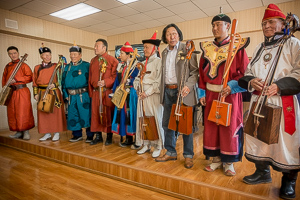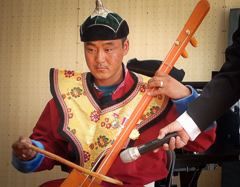Morin Khuur Symposium

Master Class Presenters (Video: Tatlag, 14:17)
It is 2016 and for the past year and a few months I have been beating my head against a musical instrument that has been played here for at least eight centuries. The heyday of its skin-covered ancestor occurred at a time when Mongolia had conquered most of Asia, the Middle East, and Eastern Europe. It was a time before cable tv or cell phone, a time when individual artists and musicians provided the cultural enrichment for both wealthy (best pay) and poor (most appreciative.) They were motivated to push the limits of what was possible in their respective crafts. Certainly competition between practitioners played a part, but also, the sharing of technique from colleague to colleague, or at least from bagsh to oiotan, teacher to student.
What remains today is music that has been hashed out and cultivated for centuries until its sound, especially for those new to it, is nearly magical. It is a gift from one generation helping the next in an effort for brains to convince fingers to do what seems impossible, especially to me, as I stare at written instructions that ask a pinky to get to one note even before it leaves another, or simply try to decipher video slowed down to where sound no longer connects to motion. Although it was not intended to be so, it is also a gift from one culture to another, expanding the range of what it means to be human, and making it deserving of the World Heritage designation it has received from the United Nations.

Ikhel Player
Today I have listened to master classes in the Morin Khuur (as well as the ikhel, its stripped-down headless cousin, which is strung "backwards" with the high string to the left) with presentations on both long song, —urtin duu, and — tatlagaan, two styles of morin khuur playing that will separate this music from anywhere else in the world. Although it is not the focus of this symposium, several players added a dose of Khuumii, Mongolian throat singing, which is also unique to this country.
Urtin duu, long song, is the name for a style of singing that s-t-r------e-------t-c-h-----e----------s a sentence, or even a few words out for an entire performance. (You'll want to choose your words carefully.) Instrumental accompaniment must go with the flow, for when the score is written, it is marked Rubato; there is no strict prescription for the time a singer will take to work through these syllables. (Think about it. How long is long?)
Tatlagaan, literally "pulling," is a whole family of music that includes rhythmic tributes to horses, camels, and other prominent, persistent, repetitive features of Mongolian life. While Urtin Duu that is sung might make you curious about what your own vocal cords will permit, Tatlag will urge you, in a very persuasive way, to get up and move.
Battugs found me a seat in the first row and with his uneasy English and my shaky Mongolian, made it known that I should photograph the players so that I could see their fingers as they played. I hope there will be a time when watching these videos will help me, but for now it is way above my head. I simply enjoy the listening and marvel at the players' skill and ease.
Recently I was explaining this instrument to someone in the United States. He asked how many strings it had, and I explained that there were only two, that they were bowed something like a cello, that they were lightly touched instead of being pressed to a fingerboard, that not only were they played in harmony, but also harmonically, the same fingering at a lighter touch producing a sound an octave or two higher than normal. He tilted his head as I tried to explain, but I could see that he was still stuck on that first part. "Only two?" he asked again, to make sure he had gotten that number right, and to verify that it was not really so complicated.
Two strings, yes. Here is a small sample—five players from various parts of the country performing Tatlag. Urtin duu will have to wait till later.